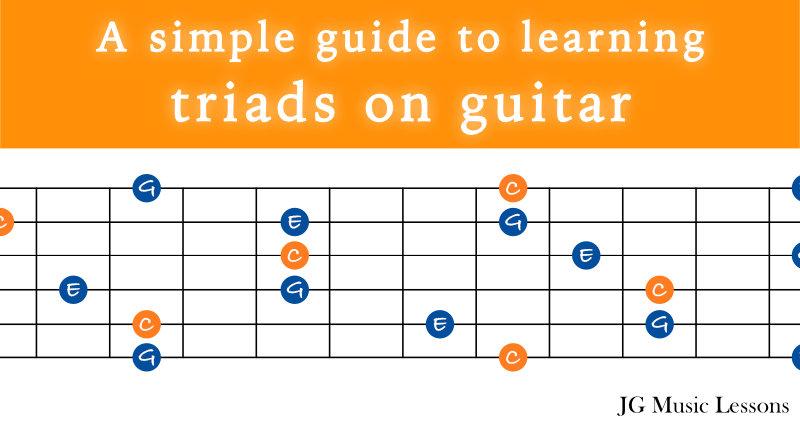Perhaps you’ve heard the musical term “triads’ but aren’t sure what it even means or how they are used on guitar. This lesson covers the music theory to help you understand triad chords, learn different shape examples on the guitar, and how to apply them in different musical situations.
Grab your guitar and let’s get started!
What is a triad in music?
In music, a triad is a structure that is built on three notes to make up a chord. The three notes in a triad can be played simultaneously or as a series of individual notes known as an arpeggio.
Major triad chords are built on the chord tones 1, 3, and 5. Minor triad chords are built on the chord tones 1, b3, and 5. For example:
- C Major triad has the notes C, E, and G
- C minor triad has the notes C, Eb, and G.
Formula for triad chords
There are different kinds of triads such as Major, minor and diminished but in this lesson, we will cover the more common ones which are the Major triad and minor triad.
Here are the formulas you can use to get the notes of any Major or minor triad using whole and half steps between each note.
Major triad formula

Major triad formula
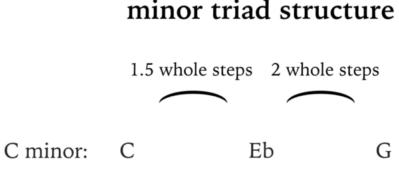
Major and minor triad in notation
This is what these chords would look like in notation:

If you notice, the only difference between a Major and minor triad is the middle note. To change the Major triad to a minor triad, you need to lower the middle note a half step below. Likewise, you would raise the middle note of a minor triad a half step up to turn it into a Major triad.
Tip* If you’re familiar with scales, another way you can find the three notes of a triad is to pick out the 1st, 3rd, and 5th note of the scale.
Did you know that most of the first chords beginning guitarists learn are triad chords with some notes being repeated? Check out this other lesson to master the basic chords on guitar.
Triad chord inversions
The beauty of triad chords is they can be played in inversions, meaning the bass note changes to rearrange the order and sound of the chord. This can sound great if the same chord repeats for a while and you want to play different sounds over it.
Knowing your chord inversions will also help you to transition to other chords smoothly as you’ll see in the examples later on.
Here are three ways to play a C Major chord in notation in below.

Whenever you come across chords that have a bass note other than the root, you use a slash to notate this. For example:
- C/E means you play a C chord with E in the bass.
- C/G means you play a C chord with a G in the bass.
Note that you can also drop the middle note to the bass to create spread triad chords (see lessons here).
You can also have bass notes that are not part of the chord. To learn more, check out this lesson on slash chords on guitar.
Guitar triad shapes and inversions
As you may or may not know, there are many different ways you can play the same thing on the guitar. Here are some practical triad chord shapes and the inversions that you can use for C Major and C minor, starting on the 3rd and 4th strings.
It helps to know all of the notes on the guitar fretboard because you want to be able to find different ways to play the notes in a triad.
Major triad shapes starting on the 4th string

Major triad shapes starting on the 3rd string

Minor triad shapes starting on the 4th string

Minor triad shapes starting on the 3rd string

These chords and their inversions can also be done starting on the 5th and 6th string but I recommend starting with these first before moving on.
Also, these chords can be extended to more than three notes, meaning that certain notes of the triad can be repeated but for now, learning these basic triad forms is a good place to start.
Moving triad chord shapes
Once you learn a triad shape on the guitar, you can conveniently shift to different starting points to play other triad chords on the same string.
The following example shows you how a triad chord is shifted throughout the fretboard to play different chords.

Using triad chords in a chord progression
If you were to play over a progression, meaning a series of chords, you can use triads to weave your way through by finding the closest related notes. This serves as a nice tool you can use for accompaniment.
Let’s say you want to play over the following chords. (Major chords are stated with just the letter name.)

The outline for these chords might look something like this, using a very simple rhythm (all whole notes).
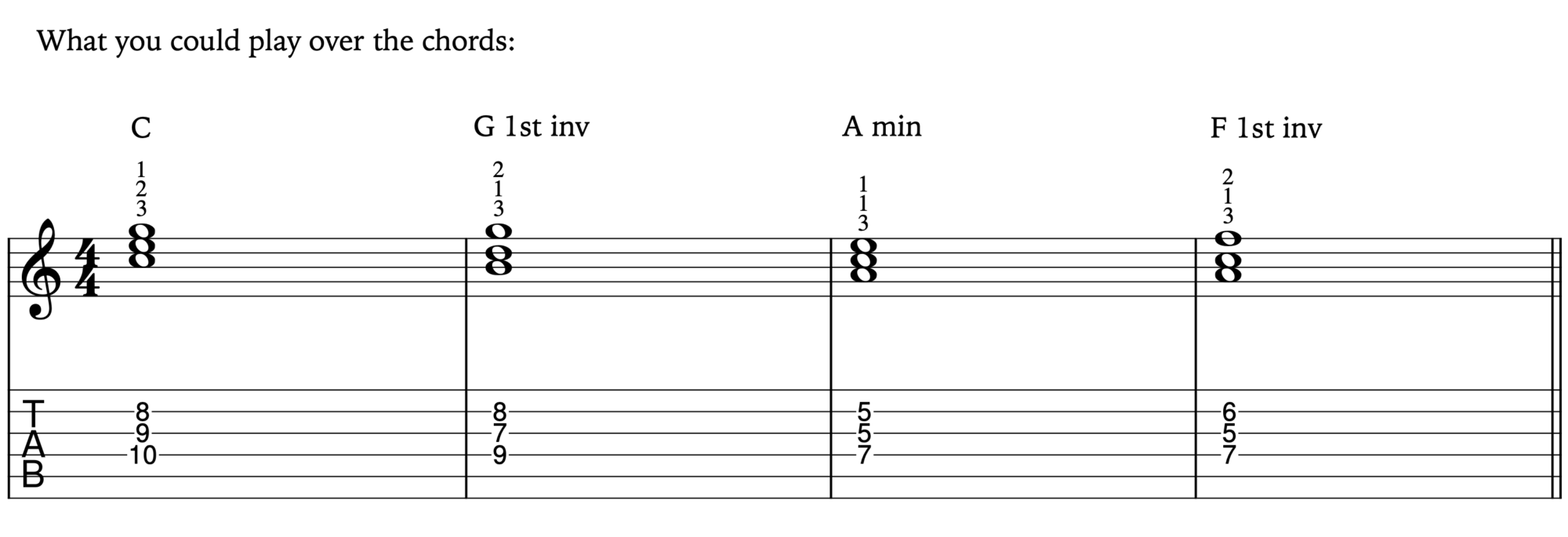
You can see how we are keeping the notes between chords relatively close together to play a smoother transition between them.
Now that we know what notes we can use for each chord, we can play these triads by separating the notes to create more a rhythmic and musically interesting pattern. Check out the example to show you what I mean.
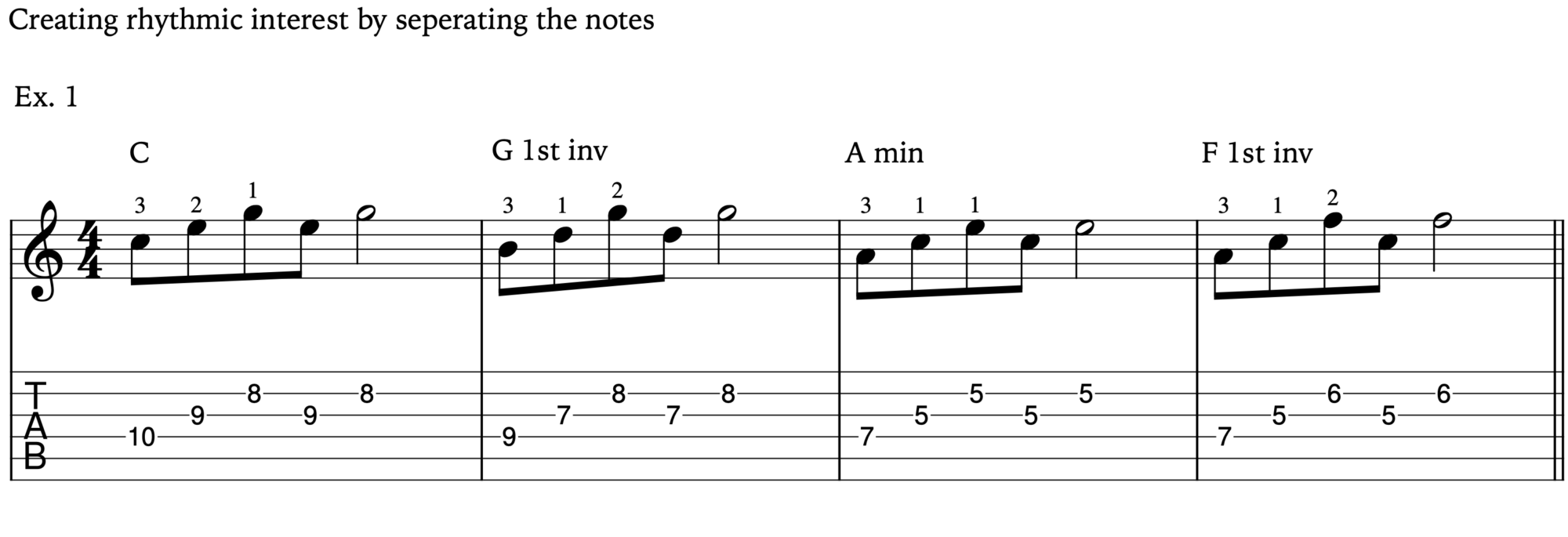
Here is another rhythmic variation using the same triads.

Connecting triad shapes on the fretboard
The following chart helps you to visualize what all the notes of a C Major triad look like if you incorporated all the strings. Ultimately, you will want to know as many variations for any given chord so that you comfortably move around the fretboard. The shapes apply to any Major chord but you have to shift the shapes to the root note accordingly.
The orange circles indicate all the root notes to serve as guides around the fretboard.
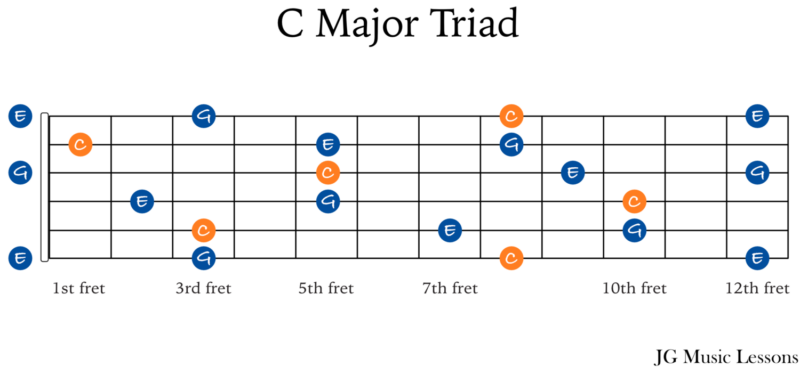
Triads mini quiz
To test your knowledge on how the Major and minor triad structures work, why not try and figure out the three chord tones for each of the chords below? Tip* When counting the steps between notes, the notes B to C and E to F are the exceptions which are a half step apart. Here are the triad chords below.
- A minor triad
- G Major triad
- D Major triad
- E Major triad
- A Major triad
- B Major triad
- D minor triad
- E minor triad
- G minor triad
- B minor triad
Answers will be posted in the next section!
Triad Quiz Answers
Here is the answer key for the previous quiz questions.
- A minor triad– A, C, E
- G Major triad – G, B, D
- D Major triad – D, F#, A
- E Major triad – E, G#, B
- A Major triad – A, C#, E
- B Major triad – B, D#, F#
- D minor triad – D, F, A
- E minor triad – E, G, B
- G minor triad – G, Bb, D
- B minor triad – B, D, F#
Wrapping up
I hope this has helped you to understand what triads are and how they can be applied in a musical context. There are so many possibilities with triads so it’s worth exploring them in more detail so you can play any given inversion for a chord.
Not only will triads help you to play more smoothly between chords but in another sense, you unlock a greater understanding of the fretboard. These triads are the building blocks that makeup more complex chords and can also serve as a great tool to start your journey of improvising on your instrument.
To dive deeper on this subject, check out how to practice Major triads or minor triads on guitar.
📘 Get the free guitar practice guide here!
All the best,
JG Music Lessons
Start Playing Better, Faster
by becoming a Pro Member! ✨
Transform your playing by enjoying benefits such as:
• 📙 Exclusive Lesson PDFs and Ebooks
Get access to a growing library of clear, downloadable resources—save time and skip the clutter.
• 🎼 Full Song Lessons
Break down your favorite songs step by step, and play them with confidence.
• 🚫 Ad-Free Learning
Focus better with a distraction-free environment.
• 🎁 Store Discounts
Save 50% off on all song PDFs, charts, audio tracks, bundles, and design printables.
• 💬 Member Support
Got questions? We’ve got your back, helping you stay on track!
👉 Join Here!
📙 Kickstart your guitar playing with our step by step guide: Guitar Essentials.
🎸 Looking for a travel or half-sized guitar? See this one.
🛠 See our other music recommendations.
🤝 Support the site to help us to create better content for you!
Level up with the FREE guitar practice guide and effectively improve your playing! 🎸
Get it sent to your email!

